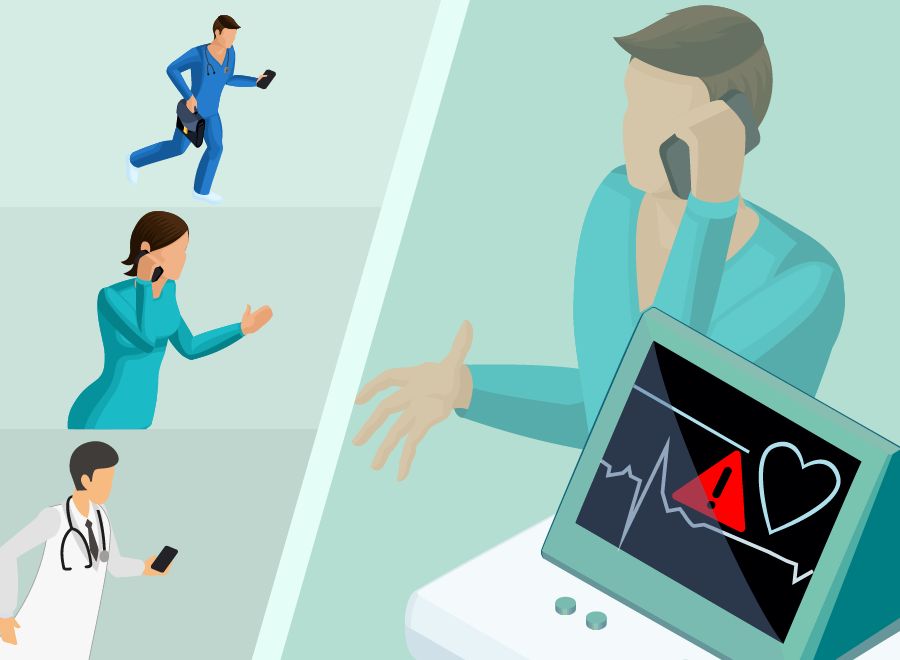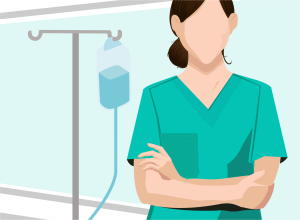© tetronik GmbH. All rights reserved.
© tetronik GmbH. All rights reserved.
Mobilize Resuscitation Team in Case of a Code Blue Alarm
Respond quickly and safely to code blue alarms
Emergencies are part of the every-day routine in any hospital or clinic. Time and again sensitive in-hospital situations like a code blue alarm occur, also outside the typical critical areas such as intensive care units, cardiology and operating theaters, and every single one of these moments requires immediate professional medical care. To respond to all of these emergencies in the best possible way, hospitals form medical emergency teams or METs, consisting of members from different specialist departments, defibrillators are positioned in strategic locations and regular exercises are carried out.
And yet, in emergency situations valuable time is frequently lost because communication processes are handled manually instead of being automated. Therefore, a paramount strategy to significantly improve the chances of success of a hospital's rescue measures is to automate emergency communication.

This is how the code blue patient receives the best possible care

A patient is found in critical condition
Nurse Daniel finds a patient in serious condition on his ward. Quick-wittedly, he immediately dials the internal emergency number set up for this purpose.

DAKS automatically calls the right people
The DAKS alarm server automatically triggers a predefined communication process:
DAKS sends a code blue alarm directly to the mobile devices of emergency team members. It takes into account staff rosters and calls only those team members who are on duty. Less important phone calls can be interrupted for the emergency call.
DAKS assembles the exact number needed from each specialist department. If individual MET members are unavailable or unable to respond because they are already on duty as part of another emergency, DAKS immediately forwards the emergency call to other candidates. In this manner, complete emergency teams can be put together more quickly.

The emergency team can get organized
DAKS connects the team members with each other and with nurse Daniel in an emergency broadcast call. This immediate voice contact is of vital importance, because it allows all those involved to agree on the appropriate course of action even before the emergency team arrives. They can identify those helpers who are already closest to the patient and, if necessary, guide nurse Daniel in first aid measures. In addition, relevant information about the patient (exact symptoms, specific risk factors, etc.) can already be collected at this stage.

Clear location information saves time
With the emergency call, Daniel's phone number is forwarded to the phones of the team members as a display message. Even if the call is interrupted, it is possible to see from who initiated the call. With the optional use of a Positioning System, the whereabouts of the person who triggered the alarm can also be provided.
When the emergency team arrives, nurse Daniel has already done good groundwork and the patient is immediately given further care by the doctors.
Benefits of putting together emergency teams automatically

Increase safety and clarity on the side of the patient
- The patient can be helped more quickly.
- DAKS has a supporting influence that increases the chances of success of any in-hospital rescue measure.
- The person who sets off the emergency call gets clear and professional instructions over the phone and is enabled to actively and effectively participate in the immediate first aid measures.
- Providing this direct over-the-phone voice support and assuring the emergency caller that the MET will arrive at the scene within the shortest time possible gives the confidence that is needed to take the right action when every moment counts.

More efficiency and verifiability for the clinic
- The automatically convened emergency broadcast call makes it possible to discuss further measures while still on the way to the patient.
- Medical emergency teams are better informed, arrive faster where they are needed most and are able to provide better help and administer the right professional treatment.
- The fact that DAKS fully logs all incoming emergency calls guarantees comprehensive evaluability. DAKS is the basis for higher quality in medical emergency care.
- Doctors, physicians and hospital staff feel safer.
- DAKS helps to build increased trust in your hospital.
Video of the solution
Discuss your individual
application project with us
Add this solution
to your shortlist
Related Application Examples

Automate Trauma Room Alerting

Design IoT Workflows in Nursing More Securely

Alarm Management in Intensive Care Units
- Home
- Applications
- Healthcare
- Mobilize Resuscitation Team in Case of a Code Blue Alarm
© tetronik GmbH. All rights reserved.





